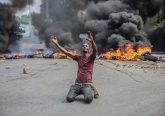On 18 July 2014 the world awakened to yet another tragedy: the downing of the Malaysian Airlines flight HM17 over pro-Russian separatist territory of Ukraine, which in its horrendous totality shocked the collective conscience of the public. Claims of responsibility for the tragedy spread over the then innocuous social media portal, Twitter, and instantly internationalized what had been perceived as a largely domestic conflict. What gradually came into view was the deployment of Twitter as a propaganda tool and a means for nefarious communication, subject to virtual deletion and emendation for the purposes of advancing a military objective and a political cause. References to tweets and videos bearing an imprint of responsibility were invoked in the Security Council’s emergency meeting hours later, where the US Ambassador to the United Nations, Samantha Power, cited them in her impassioned speech.
This raises a legal conundrum, namely, what is the legal status of a boastful Twitter confession by separatist leaders of a state-sponsored rebel group containing first-hand accounts and admissions of responsibility for shooting down a plane in the midst of a conflict? Are tweets a novel form of incriminating evidence in a rapidly changing terrain of modern warfare? What ought to be their evidentiary value and legal status under international criminal law, international law of armed conflict and international humanitarian law? Finally, what criminal liability should those claiming responsibility bear under domestic and international law?
Colateral Damage
Protocol I of 1977, Additional to the 1949 Geneva Conventions warns that: “an attack which may be expected to cause incidental loss of civilian life, injury to civilians, damage to civilian objects, or a combination thereof, which would be excessive in relation to the concrete and direct military advantage anticipated” is forbidden and tantamount to a war crime. In the fog of war, the key principle that commanders of armies are to hold sacrosanct is the distinction contained in Article 48 of Additional Protocol I, which mandates discrimination between belligerents and non-belligerents and military versus civilian objects. This generally accepted norm holds that all objectives which are “not military are considered civilian, and may not be made the object of direct attack or of reprisals.”
In the spirit of the fundamental legal precept of pacta sunt servanda, the principles of the Law of Armed Conflict (LOAC) are binding upon parties to it and must be performed in good faith. A degree of reciprocity in honouring the laws of war is therefore a mitigating factor in the dehumanizing machinery of armed conflagrations. It is incumbent upon the parties to the conflict to adhere to customary international law and fundamental protocols, which privilege and essentialize human life. Thus Protocol I of 1977 forbids an indiscriminate attack that appears excessive or disproportionate to the military objectives sought.
Furthermore, Article 8(2)(b)(iv) of the Rome Statute of the International Criminal Court criminalizes “intentionally launching an attack in the knowledge that such attack will cause incidental loss of life or injury to civilians or damage to civilian objects or widespread, long-term and severe damage to the natural environment which would be clearly excessive in relation to the concrete and direct overall military advantage anticipated.” Application requires, inter alia, an assessment of: (a) the anticipated civilian damage or injury; (b) the anticipated military advantage; (c) and whether (a) was “clearly excessive” in relation to (b).
A deafening silence
But the modern jus in bello’s embrace of proportionality does not and cannot preclude and eliminate accidental injuries to non-belligerents. Therefore, as Yoram Dinstein claims, “even after the endorsement of the principle of proportionality…the danger of incidental injury to civilians – as a collateral damage resulting from attacks against military objectives – cannot be lightly dismissed.” Especially challenging, here, are the non-state actors and terrorist organizations involved in a protracted conflict with regular state armies, which choose to operate from within civilian encampments, whether it is Hezbollah in Lebanon, Hamas in the Palestinian territory, or the Twitter-savvy separatist rebels in eastern Ukraine, thus threatening to expose a large non-belligerent population to harm, injury or death.
Recent events in eastern Ukraine, Palestine, and Syria should remind us that there is such a thing as the International Law of Armed Conflict or the International Humanitarian Law, which aims to limit the effects of conflict and protect civilians against the abhorrent nature and terrors of war. Yet, the disappearance of a substantive and ongoing dialogue, unsoiled by political manoeuvres and economic calculations, from the UN Security Council and the very institutions vested with maintaining peace and security in an ever uncertain world, also reveal the inherent limitations of international law itself.
The cumulative effects of this deafening silence dim any hopes of putting in place legal mechanisms aimed at properly investigating crimes broadcast on Twitter by rebel forces of questionable origin. Fading fast, too, are the chances of ascribing individual criminal responsibility to the patrons of such crimes, who are given a far too liberal reign to reshape the borders and histories of entire nations without the necessary scrutiny called for by a fragile human conscience and a full and impartial review mandated by law.
This post first appeared on the website of OpenDemocracy under the title The fog of war.








No Comment